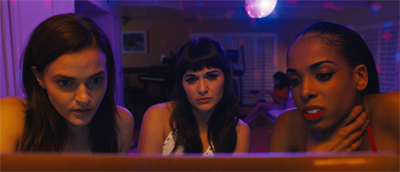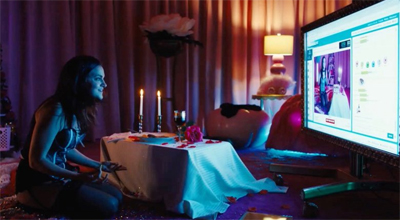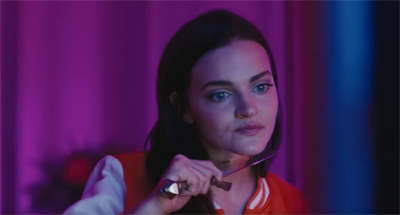The most horrific aspects of Cam have little to do with the literal monster lurking at its core.
It is almost half an hour before the central plot of Cam kicks into gear. It is a credit to both director Daniel Goldhaber and writer Isa Mazzei that Cam sustains itself as a horror even through this (relatively) long establishing stretch. There is something inherently skin-crawling about that extended introductory sequence, which is essentially a depiction of “business as usual” for central character Alice. The opening scenes of Cam very skilfully and very creepily capture the commodification and performativity of both cam-girl-ing in particular and social media in general.

Time for reflection.
Watching the opening stretch of Cam, the audience might read social media itself as the monster, a horrific force capable of warping and bending individuals to its will. Even before Alice realises that something is wrong, there is a sense that the audience has taken a trip through the looking glass. The pink neon glow, the way the camera snakes down hallways, the casualness with which Alice picks up her dinner from a delivery man while covered in corn syrup (and little else), the repeated framing of shots to emphasise mirrors and screens as images trapped and projected.
Indeed, the obligatory bridge between the second and third acts of the film might be the biggest issue with Cam, the clumsy in-universe explanation of the strange entity lurking at the centre of the story and function that it performs. However, this is a testament to the quality and imagination of the rest of the film around that exposition. The monster in Cam is so familiar and so relevant to contemporary society that it almost needs no explanation at all. Cam is so effective a horror story that it arguably doesn’t even need its monster.

“Feed me.”
Alice is a cam-girl. She is a young woman who performs in front of a camera as part of a live stream for the amusement of her audience. It is effectively a digital update of the familiar old peeping booth concept, the commodification of sex and the commercialisation of voyeurism. Now the patrons no longer need to even be in the same country to look, and the women need no longer be within the same jurisdiction to be commodified. This is the internet. All of those urges and impulses are now both global and faster.
Indeed, Cam seems perfectly positioned at the intersection of great horror premises. This is a movie about sex and sexuality, which is the cornerstone of so many great horror films; the entire slasher film genre can be read as a treatise on repressed sexuality manifesting through (often puritanical) violence. Sex is something that makes people inherently uncomfortable in most modern cultures, and so is perfect fodder to be rendered through the lens of horror cinema. It Follows can be read in many different ways, for example, but they all filter through sexuality.

Girls on screen.
Similarly, Cam is rooted in that familiar fear of the digital frontier, a modern representation of a more basic anxiety about the speed at which society is moving and worries about technological advances. Horror is often a vehicle for exploring these anxieties about whether mankind can keep pace with its own inventions. Unfriended and Unfriended: Dark Web play with this idea, but it obviously predates the internet. Videodrome worried about the corrupting power of television, while Demon Seed dreaded even earlier computers.
Cam touches on the point of collision between these two central tenets of horror cinema; if sex is scary and the internet is scary, then surely sex on the internet is especially scary. It certainly is. To be fair, it would be tempting to write off Cam as a reactionary screed, stoking fears about female performers’ attempts to assert their sexuality on their own terms. Luckily, both Goldhaber and Mazzei understand that impulse and play with it. While the sexual component of Cam is strong and sordid, the movie arguably works best as a metaphor for the internet as a whole.

It’s all meal, meal, meal out there.
The opening half-hour of Cam is a remarkable effective piece of work, establishing who Alice is and what she’s doing. More than that, it perfectly captures the sense in which the internet warps and skews an individual’s perspectives and priorities, how social media erodes the notions of both personal identity and privacy. The advent of things like live-streaming (but also even Instagram and Twitter) have created a climate where many individuals are constantly projecting an image of themselves into the world, filtered and managed, but around the clock.
The introductory sequence of Cam captures this mood perfectly, focusing on Alice’s efforts to climb the rankings on her web-cam website. Alice is introduced to the audience already committed to performance art that reaches much further than the basic premise of web-cams, staging an especially grizzly act with the assistance of a plant in the audience. Goldhaber and Mazzei demonstrate that even after the feed ends, Alice is still curating her content. She live-streams her bath to one patron. She is sexting another while spending quality time with her mother.

All that glitters.
All of this is an elaborate game. Alice is not the woman that she plays for the camera. “Lola” is an affectation, a performance. She is essentially a piece of conceptual art, a character created through improvisation to satisfy some unconscious internet gestalt. This is a premise for a horror movie of itself. As Kurt Vonnegut argued, “We are what we pretend to be, so we must be careful about what we pretend to be.” The premise of Cam suggests itself from those opening scenes, even before anything unnatural reveals itself to be lurking; “Lola” may yet swallow Alice whole.
It could reasonably be argued that Cam is never scarier than in the opening half hour when it establishes Alice’s world while she still believes herself to be in control. The surroundings look uncanny, as if lifted from some Lynchian nightmare full of pink fur and simmering curtains. Alice’s furniture is still wrapped in plastic, suggesting how little life the young woman has outside of the time that she spends on-camera. She uses her own bedroom to broadcast. Outside of her mother and brother, the only people in her life seem to be those she knows through “Lola.”

A lot of panting…
The film returns time and again to the metaphor of the mirror, the monitor serving as just the most abstract example. One early shot features Alice in front of her vanity mirror, staring at a recording of herself on a laptop and recording a message on her phone at the same time. Repeatedly, and occasionally even literally, the film suggests that Alice might be trying to capture and tame her own image before it escapes into the larger world. This is the fear at the heart of Cam. What if the image of a thing could become the thing itself?
Again, it should be acknowledged that Cam treats Alice and her world with a lot of consideration and respect. Alice is presented as somebody who takes her profession as seriously as any other craftsperson. She puts the work in. “Go away,” she tells her cats as she studies the performances from her rivals, “I’m studying.” Madeline Brewer does very good work in the role of Alice, and the film imbues the character with a sense of warmth and humanity often lacking from these sorts of horror films. Then again, the tight (almost singular) focus on Alice is a boon to the film.

Kill the feed.
Cam transitions relatively effectively into a horror movie, with both Goldhaber and Mazzei understanding the mechanics and the underpinnings of the genre effectively enough to get away with fudging a few of the particulars. The precise details of the monster at the heart of the story are never explicitly articulated, and the film is more effective for that. Instead, Cam cleverly trusts the audience to understand the internal logic of the horror movie enough to go along with the premise and understand the manner in which these stories work.
Alice’s odyssey begins shortly almost a half-hour into the film. This follows a transgression for the young performer, who had earlier made a point of stressing the boundaries that she imposed upon her online persona. “I don’t do live shows,” Alice boasts, “I don’t tell my guys I love them, and I don’t fake orgasms.” Desperation forces her to break one of those rules, and it is implied – by the internal logic of horror movies – that this transgression was enough to make her vulnerable to… something. The film inherently understands that the how and the why of this is unimportant.

Meating online.
Instead, Cam focuses on the central metaphorical horror of Cam. Alice wakes up one day to discover that her screen persona has effectively escaped from her and spread into the internet. She is no longer about to control “Lola.” There are any number of possible allegorical readings of this – the manner in which nobody truly controls the way that others see them, the literal way that nobody can control their own image in the era of “deep fakes”, the fear that nothing is ever truly private in this era. All of these ideas bubble through Cam.
Again, the film works best when it drifts away from the particulars of this individual story and towards the more abstract ideas with which it is playing. Her mother seems almost thrilled at the confidence that her daughter displays on line, admitting, “I wish everybody could see you like that.” Alice tries to explain the situation by stating, “That person is not me.” Her mother agrees, articulating the literalised metaphor at the heart of the film, “I get. That person is a performance.”

She seemed like such a knife girl.
Similarly, Alice’s efforts to get assistance from law enforcement will ring very true to anybody who has ever tried to deal with online harassment through those channels. “If you don’t want to see stuff like this, stay off the internet,” an officer explains to her, not at all helpfully. Similarly, Alice is slutshamed for her profession, treated as a novelty. “I’m not understanding how this works,” one officer admits. “You get paid by the minute? You have to do whatever they want you do?” He elaborates, sordidly, “What’s the weirdest thing you’ve ever had to do?”
Cam gets at anxieties both practical and existential. Any audience member who has ever found themselves locked out of an account will share Alice’s frustrations trying to explain her situation over the phone while a condescending service provider asks her to “take it down a notch.” However, there’s also a more fundamental fear concerning the personas that people craft for themselves and the manner in which these might become traps or prisons. The fundamental horror at the heart of Cam is very old indeed, even if the technology used to realise it is more modern.

She does make a bloody mess.
These are the moments in which Cam works best, embracing the raw potential of its premise. Perhaps due to its nature as an inherently trashy and experiment and exploitative genre, horror has often been much better at articulating contemporary anxieties than more prestigious and respected genres like prestige drama. It’s really no surprise that Blumhouse has become one of the most socially relevant studios in contemporary cinema. Cam is obviously a bit less pointed than Get Out, but it is still a film that understands quite explicitly what it is about.
Cam does suffer a little bit when it gets to its third act, and when it has to bring the story to a satisfying resolution. The climax itself is very effective, in large part because it works as much on a metaphorical level as a literal one, with Alice fighting to reclaim her identity in a digital hall of mirrors. However, there are a number of small leaps in plot logic that are necessary to get there, and they do not feel entirely organic. Still, these are relatively minor problems with the larger film.
Cam is an impressive piece of horror. Perhaps most impressive when the monster isn’t on screen.
Filed under: Non-Review Reviews | Tagged: cam, cam girls, commodification, film, internet, mirrors, Movie, non-review review, review, sex, web |




















Leave a comment